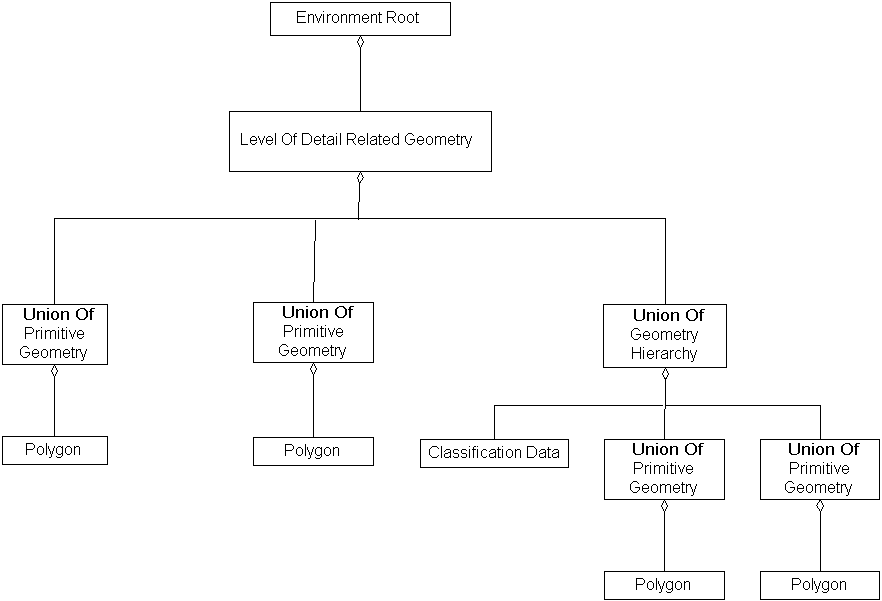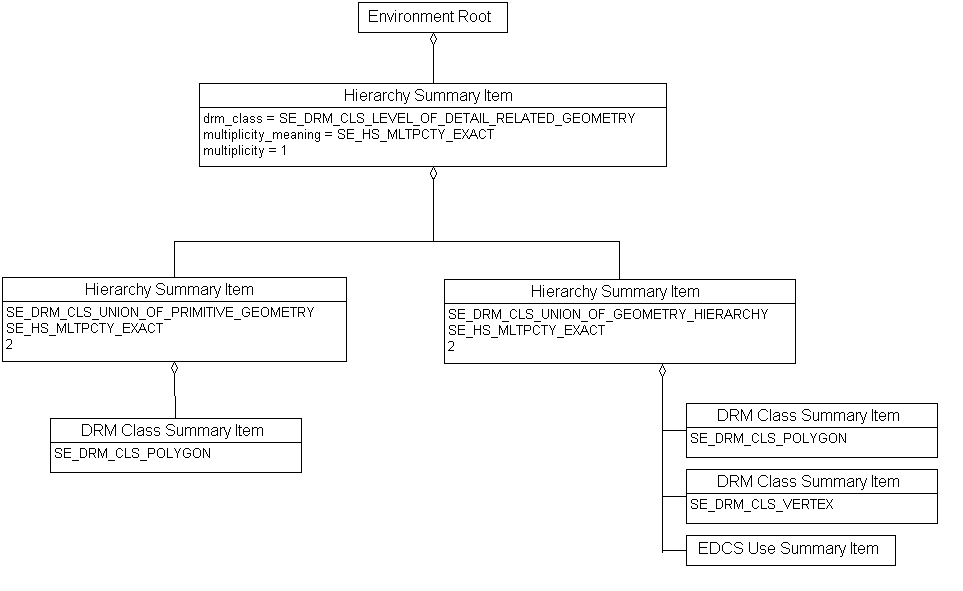The SEDRIS Data Representation Model
APPENDIX A - Classes
Hierarchy Summary Item
|
|---|
Class Name: Hierarchy Summary Item
Subclasses
This DRM class is concrete and has no subclasses.
Definition
An instance of this DRM class represents an instance, or a number of
identical instances, of a
<Geometry Hierarchy> or
<Feature Hierarchy> that exists within the
given <Model> or
<Environment Root> instance.
<Hierarchy Summary Item> instances
are combined together to form hierarchies that mirror those that they
summarize. This summary is a compressed form of the actual hierarchy, as
each <Hierarchy Summary Item> may
represent a number of instances of the class indicated by its
drm_class field.
Consequently, the
multiplicity field records how many of the given class a
<Hierarchy Summary Item> actually
represents. Note that all instances represented by one
<Hierarchy Summary Item> shall have
exactly the same hierarchical pattern beneath them, right down to
where the hierarchy summary concludes. In essence, a
<Hierarchy Summary Item> represents
both the instance(s) that it describes, and the specific hierarchy
beneath it (them); it may have an optional association to the
<Geometry Hierarchy(ies)> or
<Feature Hierarchy(ies)> that it summarizes.
Each <Hierarchy Summary Item> instance
(that is, each object type) can optionally have a list of
<EDCS Use Summary Item> instances
giving the classifications that are attached to those instances in
the transmittal being summarized.
The Hierarchy Summary does not have to be a total representation of the
entire transmittal hierarchy and can be limited to a useful high level
summary.
If the producer of the transmittal deems it of potential use to
consumers, the branches of the Hierarchy Summary can terminate with a
list of <DRM Class Summary Item>
instances representing the objects beneath that point in the hierarchy.
Primary Page in DRM Diagram:
Secondary Pages in DRM Diagram:
Example
Consider an <Environment Root>
instance for which the geometry is to be summarized.

The geometry portion of the above
<Environment Root>
can therefore summarized as follows. Note that
this is the same <Environment Root>
instance as shown above, but for readability only the
<Hierarchy Summary Item> portion
of its instance diagram is shown here.

The <Hierarchy Summary Item> tree,
rooted at the <Environment Root>,
parallels the structure of the corresponding geometry. In this instance,
the data provider has elected not to provide a detailed summary of the
<Union Of Geometry Hierarchy>'s
structure. The list of
<DRM Class Summary Item> components merely identify classes that are
somewhere below the
<Union Of Geometry Hierarchy>, rather than the patterns in which they
appear.
The <EDCS Use Summary Item>
components summarize patterns of
ECCs, possibly used together with EACs, in the context being summarized.
If the data provider wished to summarize the hierarchy of the
<Union Of Geometry Hierarchy> in
detail, its <Hierarchy Summary Item>
could be provided with appropriate
<Hierarchy Summary Item> components as desired, until the summary
reached the level of <Primitive Geometry>
and the hierarchy summary came to an end.
For examples of summaries of
<Primitive Geometry> patterns, see
<Primitive Summary Item>.
FAQs
- If the intent is for a useful high level summary, why not just have
the consumer perform a shallow breadth-first search?
The consumer could indeed compute the information, since all that
this provides is a summary of what's in the transmittal. The reason
for providing the information is to indicate that users don't have
to be exhaustive if they don't think it's appropriate / required /
necessary, or a good use of processing time, etc. Even just providing
a top level summary, allows producers to summarize. They don't have
to be complete in a legalistic way, and can therefore use this mechanism
to summarize the major hierarchical structuring, perhaps leaving out
less significant deviations from that predominant pattern. These
would turn up in a search and actually confuse the issue. If you
like, this mechanism allows a producer to sketch out the forest
without missing it for the trees.
- Why can <Environment Root> and
<Model> only have 0 - 2
<Hierarchy Summary Item>
components?
See
<<Hierarchy Summary Constraints>>.
Constraints
Associated to (one-way)
Composed of (two-way)
Composed of (two-way metadata) (inherited)
Component of (two-way)
Notes
Associated to Notes
If present, these association(s) indicate that the given
<Hierarchy Summary Item> instance summarizes the specific
<Feature Hierarchy> object tree(s) thus indicated.
If present, these association(s) indicate that the given
<Hierarchy Summary Item> instance summarizes the specific
<Geometry Hierarchy> object tree(s) thus indicated.
Composed of Notes
If present, the list of <EDCS Use Summary Item> components of
a <Base Summary Item> instance summarize EDCS usage by instances
of the class specified by drm_class that occur somewhere in
the scope being summarized.
If present, the <DRM Class Summary Item> components of a
<Hierarchy Summary Item> instance list classes for which
instances occur beneath this point in the hierarchy
being summarized.
If present, the <Hierarchy Summary Item> components of a
<Hierarchy Summary Item> instance summarize the next
level down in the component tree of the hierarchy being
summarized.
Fields Notes
The drm_class field indicates the DRM class of the object(s)
represented by the given <Base Summary Item> instance.
The multiplicity_meaning field specifies the meaning of the
multiplicity field value for the given <Hierarchy Summary Item>
instance.
The multiplicity field specifies the number of identical
instances represented, or the order of magnitude of that
number, for the given <Hierarchy Summary Item> instance.
If the multiplicity is unknown, this field's value should
be set to zero.
Prev: Hierarchy Data.
Next: HSV Colour.
Up:Index.
|
Last updated: July 16, 2004
|
Copyright © 2004 SEDRIS™
|
|

